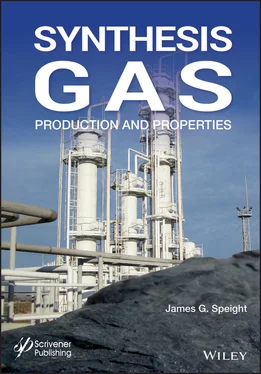Crude oil reserves (Speight, 2011a, 2014a) are the estimated quantities of oil that are claimed to be recoverable under existing operating and economic conditions. However, because of reservoir characteristics and the limitations of current recovery technologies only a fraction of this oil can be brought to the surface; it is this producible fraction that is considered to be reserves . Crude oil recovery varies greatly from oil field to oil field based on the character of the field and the operating history as well as in response to changes in technology and economics.
According to current estimates, more than three-quarters of the oil reserves of the world are located in OPEC countries. The bulk of OPEC oil reserves is located in the Middle East, with Saudi Arabia, Iran and Iraq contributing 41.8% to the OPEC total. OPEC member countries have made significant contributions to their reserves in recent years by adopting best practices in the industry. As a result, OPEC proven reserves currently stand at 1214.2 billion barrels (1214.2 x 10 9bbls) which represented 71.9% of the total crude oil reserves (BP, 2019).
There has been surprise at the OPEC estimates of proven reserves (Campbell and Laherrère, 1998) since OPEC estimates increased sharply in the 1980s, corresponding to a change in quota rules instituted by OPEC that linked a member production quota by a member country in part to its remaining proven reserves. Indeed, companies that are not subject to the federal securities laws in the United States and their related liability standards, include companies wholly owned by various OPEC member countries where the majority of reserves are located. In addition, many OPEC countries’ reported reserves remained relatively unchanged during the 1990s, even as they continued high levels of oil production. For example, estimates of reserves in Kuwait were unchanged from 1991 to 2002, even though the country produced more than 8 billion barrels (8 x 10 9bbls) of crude oil over that period and did not report any new oil discoveries. The potential disbelief in the data reported by OPEC is problematic with respect to predicting the timing of a peak in oil production because OPEC holds most of the current estimated proven oil reserves of the world.
The United States Geological Survey provides oil resources estimates, which are different from proved reserves estimates. Oil resources estimates are significantly higher because they estimate the total oil resource base of the world, rather than just what is now proven to be economically producible. Estimates of the resource by the United States Geological Survey base include past production and current reserves as well as the potential for future increases in current conventional oil reserves (often referred to as reserves growth ) and the amount of estimated conventional oil that has the potential to be added to these reserves. Estimates of reserves growth and those resources that have the potential to be added to oil reserves are important in determining when oil production may peak.
Further contributing to the uncertainty of the timing of a peak is the lack of a comprehensive assessment of oil from nonconventional sources. For example, estimates of crude oil longevity have only recently started to include oil from non-conventional sources (BP, 2019) and oil from these sources was not included in early peak oil theories. Yet oil from non-conventional sources exists in substantial amounts, which could greatly delay the onset of a peak in production. However, challenges facing this production (Speight, 2008, 2011a, 2014a, 2016) indicate that the amount of nonconventional oil that will eventually be produced is, like the peak oil theory, highly speculative. However, despite this apparent uncertainty, development and production of oil (synthetic crude oil) from the Alberta tar sands and Venezuelan extra-heavy crude oil production are under way now and the refining technologies are being adapted to produce liquid fuels from these sources (Speight, 2008, 2013b, 2013c, 2013d, 2013c, 2014a).
1.4.4 Technological Factors
In region after region, there are reports of (i) aging and depleted fields, (ii) poor quality – heavy oil, (iii) the need for enhanced recovery methods, and (iv) new areas turning out to be dry well, leading to the claim that peak oil has arrived. For example, for whatever reason, the fields in Alaska, the former Soviet Union, Mexico, Venezuela, and Norway (North Sea) are all claimed to be past their peak. It is grudgingly admitted by the peak oil theorists that there is (or there may be) a (remote or even unlikely) possibility of new finds of oil fields off the coast of West Africa, but their development is still years away, and these new finds will not be on a scale capable of making a difference. It is also further claimed that the only producers with an oil resource which may be capable of keeping oil flowing into the world market at a roughly constant level are the Middle East OPEC five – Saudi Arabia, Iran, Iraq, Kuwait and the United Arab Emirates (Fleming, 2000). However, because of much speculation on the part of the peak oil theorists, there is some difficulty when it comes to projecting the timing of a peak in oil production because (i) technological advances, (ii) increased efficiency in recovery methods and hence reduced or stable recovery economics, and (iii) environmental challenges make it unclear how much additional oil can ultimately be recovered from proven reserves or from hard-to-reach locations and from non-conventional sources.
Worldwide, industry analysts report that deepwater (depths of 1,000 to 5,000 feet) and ultra-deepwater (5,000 to 10,000 feet) drilling efforts are concentrated offshore in Africa, Latin America, and North America, and capital expenditures for these efforts are expected to grow through at least the 2020s decade. In the United States, deepwater and ultra-deepwater drilling, primarily in the Gulf of Mexico, could increase the production of crude oil but at deepwater depths, penetrating the earth and efficiently operating drilling equipment is difficult because of the extreme pressure and temperature (Speight, 2015b).
Ultimately, however, the consequences of a peak and permanent decline in oil production could be even more prolonged and severe than those of past oil supply shocks. Even then the decline rate is the subject of speculation but like death and taxes, the decline rate is happening! The most important variable is the amount of oil left in the reservoirs but, even then, this is subject to debate and error leaving the decline rate for fields in production difficult to assess (Eagles, 2006; Gerdes, 2007; Jackson, 2006, 2007). At best, generalities can be calculated. For example, for current fields in production a low decline rate would be followed by a more moderate decline rate which would result in peak oil in the near future.
Energy independence has been a non-partisan political issue in the United States since the first Arab oil embargo in 1973. Since that time, the speeches of various presidents and the Congress of the United States have continued to call for an end to the dependence on foreign oil by the United States. Nevertheless, the United States has grown more dependent on foreign oil with no end in sight. For example, in 1970 the United States imported approximately one-third of the daily oil requirement. Currently, the amount of imported oil is two-thirds of the daily requirement! The congressional rhetoric of energy independence continues but meaningful suggestions of how to address this issue remain few and far between. The economy of the United States feeds on oil and the country consumes far more oil than it can produce.
Читать дальше












